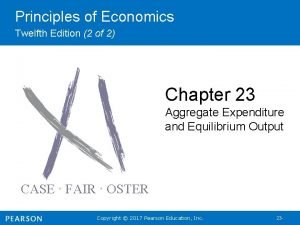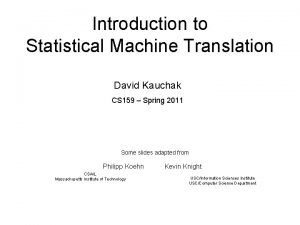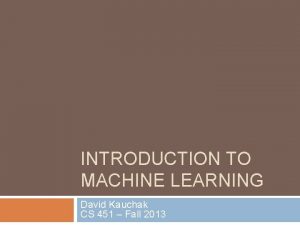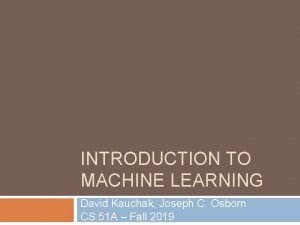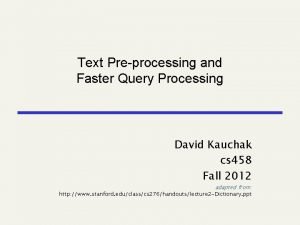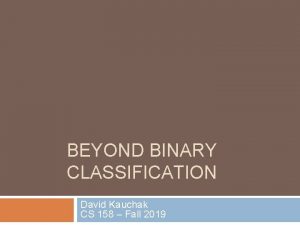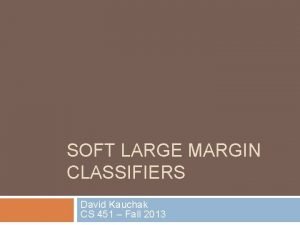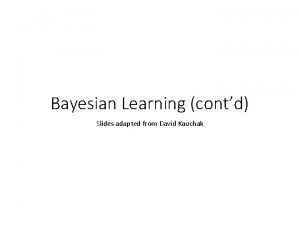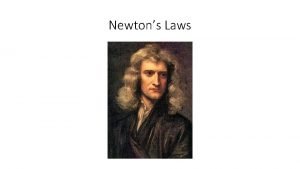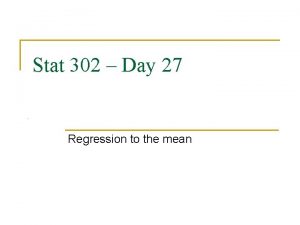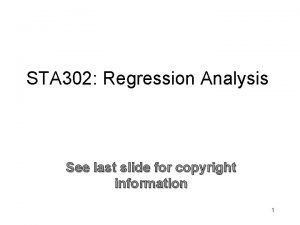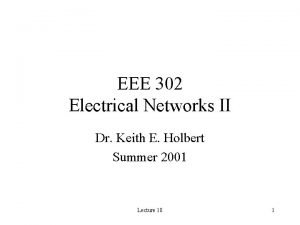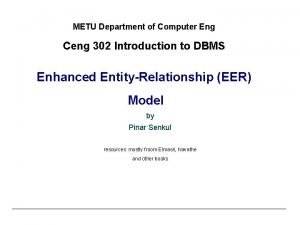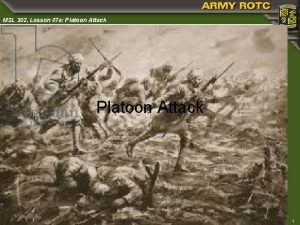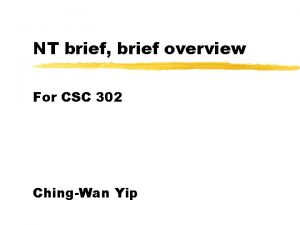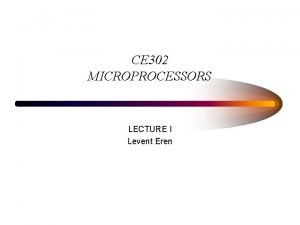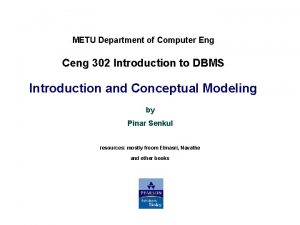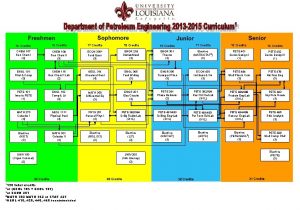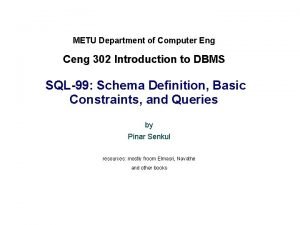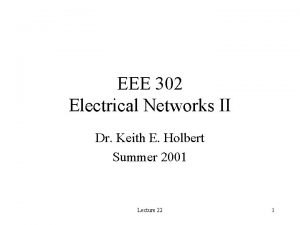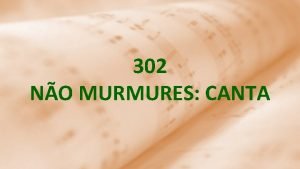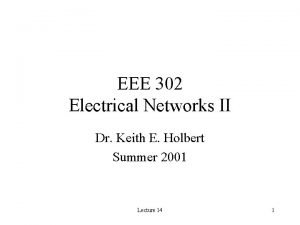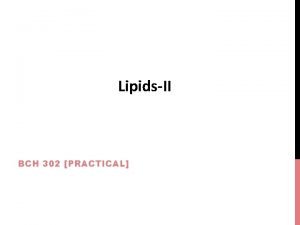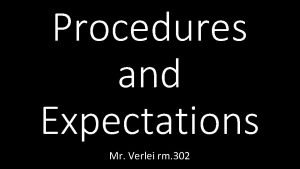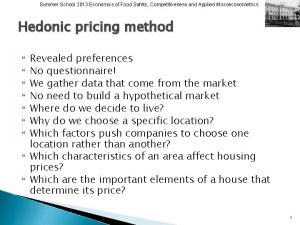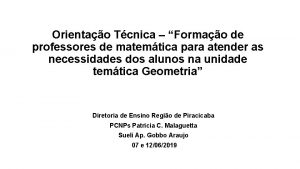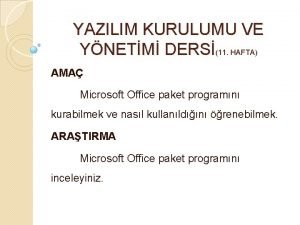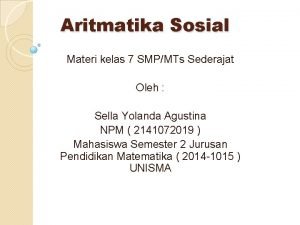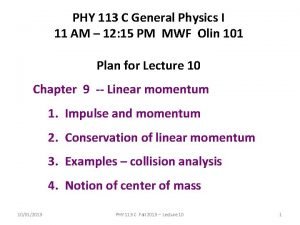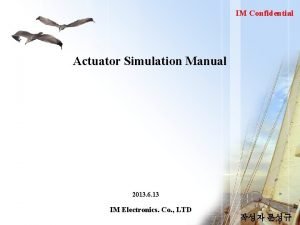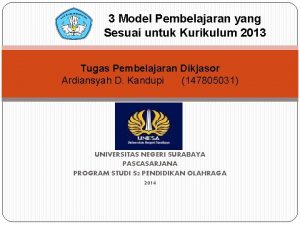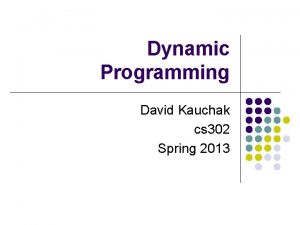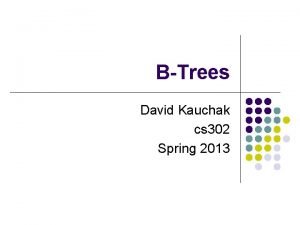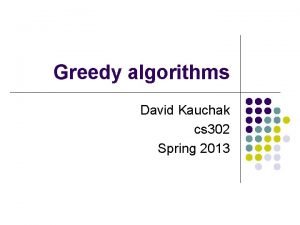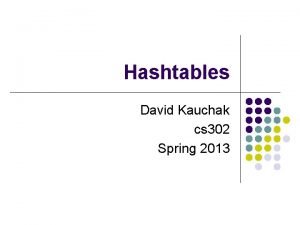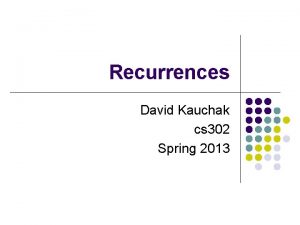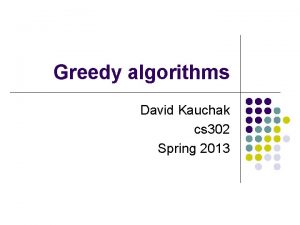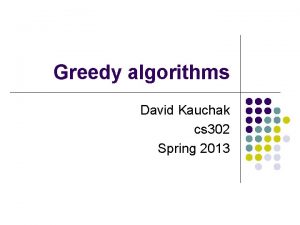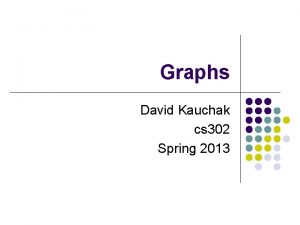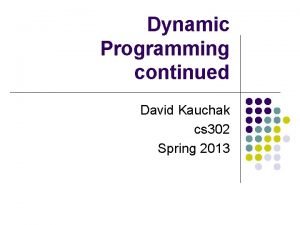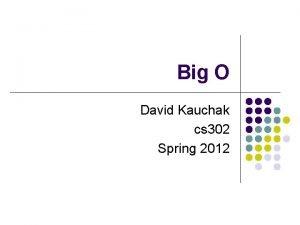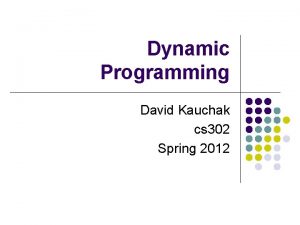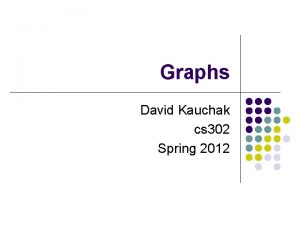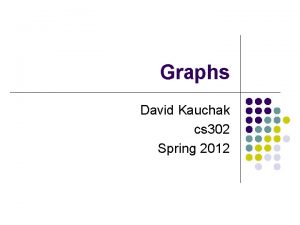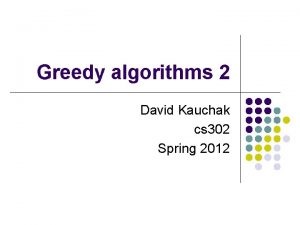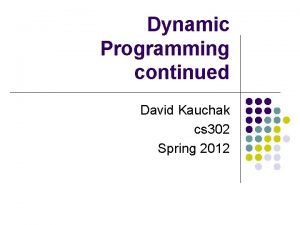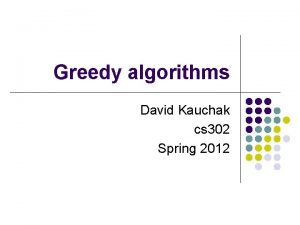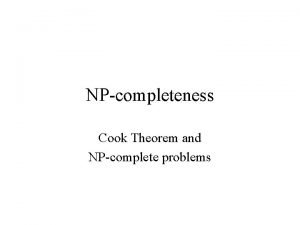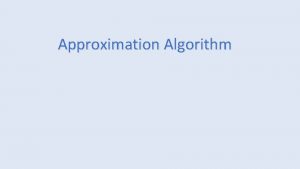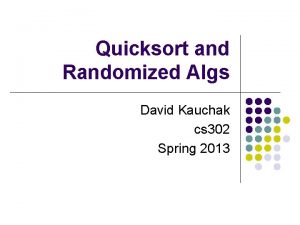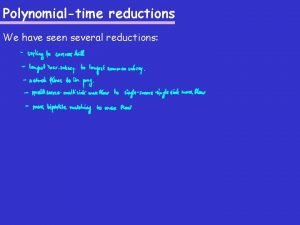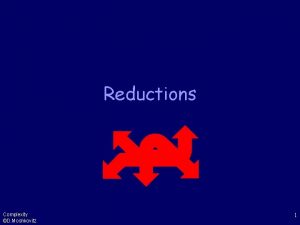NPCOMPLETE REDUCTIONS CS 302 Spring 2013 David Kauchak
























































- Slides: 56

NP-COMPLETE REDUCTIONS CS 302, Spring 2013 David Kauchak

Admin Last assignment out today (yay!) Review topics? � E-mail me if you have others… CS senior theses � Tue 3 -4, Wed 3 -4: 30, Thur 3 -4 in MBH 104

NP problems NP is the set of problems that can be verified in polynomial time A problem can be verified in polynomial time if you can check that a given solution is correct in polynomial time (NP is an abbreviation for non-deterministic polynomial time)

Reduction function

Reduction function Given two problems P 1 and P 2 a reduction function, f(x), is a function that transforms a problem instance x of type P 1 to a problem instance of type P 2 such that: a solution to x exists for P 1 iff a solution for f(x) exists for P 2 x P 1 instance f f(x) P 2 instance

Reduction function x P 1 instance f f(x) P 2 instance Allows us to solve P 1 problems if we have a solver for P answer x Problem P 1 f f(x) yes Problem P 2 no yes no

Reduction function x f f(x) Problem P 2 f’ P 2 solution Problem P 1 Most of the time we’ll worry about yes no question, however, if we have more complicated answers we often just have to do a little work to the solution to the problem of P 2 to get the answer P 1 solution

Reduction function: Example x f f(x) Problem P 2 f’ P 2 solution Problem P 1 = Bipartite matching P 2 = Network flow Reduction function (f): Given any bipartite matching problem turn it into a network flow problem What is f and what is f’? P 1 solution

Reduction function: Example x f f(x) Problem P 2 Problem P 1 f’ P 2 solution P 1 = Bipartite matching P 2 = Network flow Reduction function (f): Given any bipartite matching problem turn it into a network flow problem A reduction function reduces problems instances

NP-Complete A problem is NP-complete if: 1. 2. it can be verified in polynomial time (i. e. in NP) any NP-complete problem can be reduced to the problem in polynomial time (is NP-hard) Why are NP-complete problems interesting?

NP-Complete problems What are some of the NP-complete problems we’ve talked about (or that you know about)?

Hamiltonian cycle Given an undirected graph G=(V, E), a hamiltonian cycle is a cycle that visits every vertex V exactly once A B F D E

Longest path Given a graph G with nonnegative edge weights does a simple path exist from s to t with weight at least g?

3 D matching Bipartite matching: given two sets of things and pair constraints, find a matching between the sets 3 D matching: given three sets of things and triplet constraints, find a matching between the sets Figure from Dasgupta et. al 2008

3 -SAT A boolean formula is in n-conjunctive normal form (n-CNF) if: � � it is expressed as an AND of clauses where each clause is an OR of no more than n variables 3 -SAT: Given a 3 -CNF boolean formula, is it satisfiable?

SAT Given a boolean formula of n boolean variables joined by m connectives (AND, OR or NOT) is there a setting of the variables such that the boolean formula evaluate to true?

CLIQUE A clique in an undirected graph G = (V, E) is a subset V’ ⊆ V of vertices that are fully connected, i. e. every vertex in V’ is connected to every other vertex in V’ CLIQUE problem: Does G contain a clique of size k? Is there a clique of size 4 in this graph?

Proving NP-completeness Given a problem NEW to show it is NP-Complete Show that NEW is in NP 1. a. b. Provide a verifier Show that the verifier runs in polynomial time Show that all NP-complete problems are reducible to NEW in polynomial time 2. a. b. c. Describe a reduction function f from a known NPComplete problem to NEW Show that f runs in polynomial time Show that a solution exists to the NP-Complete problem IFF a solution exists to the NEW problem generate by f

Proving NP-completeness Show that a solution exists to the NP-Complete problem IFF a solution exists to the NEW problem generate by f � Assume we have an NP-Complete problem instance that has a solution, show that the NEW problem instance generated by f has a solution � Assume we have a problem instance of NEW generated by f that has a solution, show that we can derive a solution to the NP-Complete problem instance Other ways of proving the IFF, but this is often the easiest

HALF-CLIQUE Given a graph G, does the graph contain a clique containing exactly half the vertices? Is HALF-CLIQUE an NP-complete problem?

Is Half-Clique NP-Complete? Show that NEW is in NP 1. a. b. Provide a verifier Show that the verifier runs in polynomial time Show that all NP-complete problems are reducible to NEW in polynomial time 2. a. b. c. Describe a reduction function f from a known NP-Complete problem to NEW Show that f runs in polynomial time Show that a solution exists to the NP-Complete problem IFF a solution exists to the NEW problem generate by f Given a graph G, does the graph contain a clique containing exactly half the vertices?

HALF-CLIQUE Show that HALF-CLIQUE is in NP 1. a. b. Provide a verifier Show that the verifier runs in polynomial time Verifier: A solution consists of the set of vertices in V’ • check that |V ‘| = |V|/2 • for all pairs of u, v ∈ V’ • there exists an edge (u, v) ∈ E - Check for edge existence in O(V) - O(V 2) checks - O(V 3) overall, which is polynomial

HALF-CLIQUE 1. Show that all NP-complete problems are reducible to HALF-CLIQUE in polynomial time 2. a. Describe a reduction function f from a known NP-Complete problem to HALFCLIQUE b. Show that f runs in polynomial time c. Show that a solution exists to the NP-Complete problem IFF a solution exists to the HALF-CLIQUE problem generate by f Reduce CLIQUE to HALF-CLIQUE: Given a problem instance of CLIQUE, turn it into a problem instance of HALFCLIQUE x CLIQUE problem (Does G have clique of size k) yes no f f(x) HALF-CLIQUE problem (Does G have a clique exactly have the size) yes no

HALF-CLIQUE x CLIQUE problem (Does G have clique of size k) Three cases: 1. k = |V|/2 2. k < |V|/2 3. k > |V|/2 f f(x) HALF-CLIQUE problem (Does G have a clique exactly have the size)

HALF-CLIQUE Reduce CLIQUE to HALF-CLIQUE: Given an instance of CLIQUE, turn it into an instance of HALFCLIQUE It’s already a half-clique problem

HALF-CLIQUE Reduce CLIQUE to HALF-CLIQUE: Given an instance of CLIQUE, turn it into an instance of HALFCLIQUE We’re looking for a clique that is smaller than half, so add an artificial clique to the graph and connect it up to all vertices

HALF-CLIQUE Reduce CLIQUE to HALF-CLIQUE: Given an instance of CLIQUE, turn it into an instance of HALFCLIQUE We’re looking for a clique that is bigger than half, so add vertices until k = |V|/2

HALF-CLIQUE Reduce CLIQUE to HALF-CLIQUE: Given an instance of CLIQUE, turn it into an instance of HALFCLIQUE Runtime: From the construction we can see that it is polynomial time

Reduction proof Show that a solution exists to the NP-Complete problem IFF a solution exists to the NEW problem generate by f � Assume we have an NP-Complete problem instance that has a solution, show that the NEW problem instance generated by f has a solution � Assume we have a problem instance of NEW generated by f that has a solution, show that we can derive a solution to the NPComplete problem instance

Reduction proof Given a graph G that has a CLIQUE of size k, show that f(G, k) has a solution to HALF-CLIQUE If k = |V|/2: � the graph is unmodified � f(G, k) has a clique that is half the size

Reduction proof Given a graph G that has a CLIQUE of size k, show that f(G, k) has a solution to HALF-CLIQUE If k < |V|/2: � we added a clique of |V|- 2 k fully connected nodes � there are |V| + |V| - 2 k = 2(|V|-k) nodes in f(G) � there is a clique in the original graph of size k � plus our added clique of |V|-2 k � k + |V|-2 k = |V|-k, which is half the size of f(G)

Reduction proof Given a graph G that has a CLIQUE of size k, show that f(G, k) has a solution to HALF-CLIQUE If k >|V|/2: � we added 2 k - |V| unconnected vertices � f(G) contains |V| + 2 k - |V| = 2 k vertices � Since the original graph had a clique of size k vertices, the new graph will have a half-clique

Reduction proof Given a graph f(G) that has a CLIQUE half the elements, show that G has a clique of size k Key: f(G) was constructed by your reduction function Use a similar argument to what we used in the other direction

Independent-Set Given a graph G = (V, E) is there a subset V’⊆ V of vertices of size |V ‘| = k that are independent, i. e. for any pair of vertices u, v ∈ V’ there exists no edge between any of these vertices Does the graph contain an independent set of size 5?

Independent-Set Given a graph G = (V, E) is there a subset V’⊆ V of vertices of size |V ‘| = k that are independent, i. e. for any pair of vertices u, v ∈ V’ there exists no edge between any of these vertices Independent-Set is NP-Complete

CLIQUE revisited A clique in an undirected graph G = (V, E) is a subset V’ ⊆ V of vertices that are fully connected, i. e. every vertex in V’ is connected to every other vertex in V’ CLIQUE problem: Does G contain a clique of size k? Is CLIQUE NP-Complete?

Is CLIQUE NP-Complete? Show that CLIQUE is in NP 1. a. b. Provide a verifier Show that the verifier runs in polynomial time Show that all NP-complete problems are reducible to CLIQUE in polynomial time 2. a. b. c. Describe a reduction function f from a known NP-Complete problem to CLIQUE Show that f runs in polynomial time Show that a solution exists to the NP-Complete problem IFF a solution exists to the CLIQUE problem generate by f Given a graph G, does the graph contain a clique containing exactly half the vertices?

Independent-Set Given a graph G = (V, E) is there a subset V’⊆ V of vertices of size |V ‘| = k that are independent, i. e. for any pair of vertices u, v ∈ V’ there exists no edge between any of these vertices. Is there an independent set of size k? Reduce Independent-Set to CLIQUE

Independent-Set to Clique Given a graph G = (V, E) is there a subset V’⊆ V of vertices of size |V ‘| = k that are independent, i. e. for any pair of vertices u, v ∈ V’ there exists no edge between any of these vertices Both are selecting vertices Independent set wants vertices where NONE are connected Clique wants vertices where ALL are connected How can we convert a NONE problem to an ALL problem?

Independent-Set to Clique Given a graph G = (V, E), the complement of that graph G’ = (V, E) is the a graph constructed by remove all edges E and including all edges not in E For example, for adjacency matrix this is flipping all of the bits f(G) return G’

Reduction proof Show that a solution exists to the NP-Complete problem IFF a solution exists to the NEW problem generate by f � Assume we have an Independent-Set problem instance that has a solution, show that the Clique problem instance generated by f has a solution � Assume we have a problem instance of Clique generated by f that has a solution, show that we can derive a solution to Independent. Set problem instance f(G) return G’

Proof Given a graph G that has an independent set of size k, show that f(G) has a clique of size k � By definition, the independent set has no edges between any vertices � These will all be edges in f(G) and therefore they will form a clique of size k

Proof Given f(G) that has clique of size k, show that G has an independent set of size k � By definition, the clique will have an edge between every vertex � None of these vertices will therefore be connected in G, so we have an independent set

Independent-Set revisited Given a graph G = (V, E) is there a subset V’⊆ V of vertices of size |V ‘| = k that are independent, i. e. for any pair of vertices u, v ∈ V’ there exists no edge between any of these vertices Is Independent-Set NP-Complete?

Independent-Set revisited Given a graph G = (V, E) is there a subset V’⊆ V of vertices of size |V ‘| = k that are independent, i. e. for any pair of vertices u, v ∈ V’ there exists no edge between any of these vertices Reduce 3 -SAT to Independent-Set

3 -SAT to Independent-Set Given a 3 -CNF formula, convert into a graph For the boolean formula in 3 -SAT to be satisfied, at least one of the literals in each clause must be true In addition, we must make sure that we enforce a literal and its complement must not both be true.

3 -SAT to Independent-Set Given a 3 -CNF formula, convert into a graph For each clause, e. g. (a OR not(b) OR C) create a clique containing vertices representing these literals ~b a c - for the Independent-Set problem to be satisfied it can only select one variable - to make sure that all clauses are satisfied, we set k = number of clauses

3 -SAT to Independent-Set Given a 3 -CNF formula, convert into a graph To enforce that only one variable and its complement can be set we connect each vertex representing x to each vertex representing its complement ~x d ~b b a c e

Proof Given a 3 -SAT problem with k clauses and a valid truth assignment, show that f(3 -SAT) has an independent set of size k. (Assume you know the solution to the 3 -SAT problem and show to get the solution to the independent set problem)

Proof Given a 3 -SAT problem with k clauses and a valid truth assignment, show that f(3 -SAT) has an independent set of size k. (Assume you know the solution to the 3 -SAT problem and show to get the solution to the independent set problem) Since each clause is an OR of variables, at least one of the three must be true for the entire formula to be true. Therefore each 3 -clique in the graph will have at least on node that can be selected.

Proof Given a graph with an independent set S of k vertices, show there exists a truth assignment satisfying the boolean formula � For any variable xi, S cannot contain both xi and ¬xi since they are connected by an edge � For each vertex in S, we assign it a true value and all others false. Since S has only k vertices, it must have one vertex per clause

More NP-Complete problems SUBSET-SUM: � Given a set S of positive integers, is there some subset S’⊆ S whose elements sum to t. TRAVELING-SALESMAN: � Given a weighted graph G, does the graph contain a hamiltonian cycle of length k or less? VERTEX-COVER: � � Given a graph G = (V, E), is there a subset V’⊆V such that if (u, v)∈E then u∈V’ or v∈V’? The extra credit was to solve this problem for bipartite graphs

Our known NP-Complete problems We can reduce any of these problems to a new problem in an NP-completeness proof SAT, 3 -SAT CLIQUE, HALF-CLIQUE INDEPENDENT-SET HAMILTONIAN-CYCLE TRAVELING-SALESMAN VERTEX-COVER SUBSET-SUM

Search vs. Exists All the problems we’ve looked at asked decision questions: Is there a hamiltonian cycle? � Does the graph have a clique of size k? � Does the graph has an independent set of size k? �… � For many of the problems with a k in them, we really want to know what the largest/smallest one is What is the largest clique in the graph? � What is the shortest path that visits all the vertices exactly once? �

P vs. NP The big question: NP P=NP ? Someone finds a polynomial time solution to one of the NP-Complete problems P NP-Complete problems are somehow harder and distinct

Solving NP-Complete problems http: //www. tsp. gatech. edu/index. html
 Firms react to unplanned inventory reductions by
Firms react to unplanned inventory reductions by Translation process
Translation process Cs 451
Cs 451 David kauchak
David kauchak Lebensversicherungsgesellschaftsangestellter
Lebensversicherungsgesellschaftsangestellter David kauchak
David kauchak David kauchak
David kauchak David kauchak
David kauchak Introduction to teaching: becoming a professional
Introduction to teaching: becoming a professional Spring, summer, fall, winter... and spring (2003)
Spring, summer, fall, winter... and spring (2003) Spring is green summer is bright autumn is yellow
Spring is green summer is bright autumn is yellow A rightward force of 302 n is applied
A rightward force of 302 n is applied 7285 x 302
7285 x 302 Regression fallacy
Regression fallacy Sta 302
Sta 302 Eee 302
Eee 302 Bme 302
Bme 302 Pp 302
Pp 302 Ceng 302
Ceng 302 Lesson 302
Lesson 302 302 commitment
302 commitment Csc 302
Csc 302 Nur 302
Nur 302 Eren outline
Eren outline Cven 302
Cven 302 Suprasil 311
Suprasil 311 Ceng302
Ceng302 Bus 302 csun
Bus 302 csun Mat 302 bmcc
Mat 302 bmcc Ceng 302
Ceng 302 Eee 302
Eee 302 Invés de murmurares canta
Invés de murmurares canta Nispom 1-302
Nispom 1-302 Renungan sabtu sunyi
Renungan sabtu sunyi Cow metu
Cow metu Eee 302
Eee 302 Growth and development
Growth and development Non essential fatty acids
Non essential fatty acids Rm 302
Rm 302 Titi 2013
Titi 2013 Lync 2013 features
Lync 2013 features Vrgu
Vrgu Hosted lync
Hosted lync Summer school 2013
Summer school 2013 Www.wde
Www.wde Tipo de polígonos
Tipo de polígonos Office 2013 sistem gereksinimleri
Office 2013 sistem gereksinimleri Tema iht kurikulum 2013
Tema iht kurikulum 2013 Aritmatika sosial smp kelas 7
Aritmatika sosial smp kelas 7 Collision physics
Collision physics Decreto 1683 de 2013
Decreto 1683 de 2013 Psle 2013
Psle 2013 Pmi procurement
Pmi procurement 2013/6/13
2013/6/13 Writing to learn
Writing to learn Iso 690:2013
Iso 690:2013 Model model pembelajaran kurikulum 2013
Model model pembelajaran kurikulum 2013
